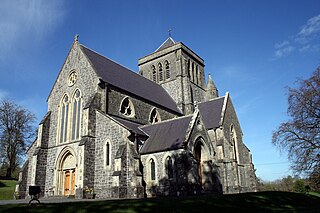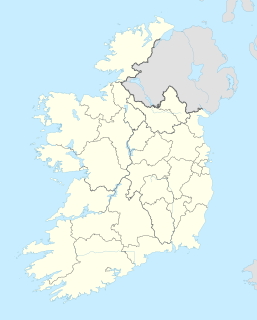This page is based on this
Wikipedia article Text is available under the
CC BY-SA 4.0 license; additional terms may apply.
Images, videos and audio are available under their respective licenses.

The Rt. Rev. William Bedell, D.D., was an Anglican churchman who served as Lord Bishop of Kilmore, as well as Provost of Trinity College Dublin.
Kilmore may refer to several places:
The Diocese of Elphin was established following the Synod of Rathbreasail in the year 1118. In that year the see for east Connacht was moved from Roscommon. Elphin was the traditional site of a monastic house established by St Patrick c.450, although there are no remains of that date.

The United Provinces of Armagh and Tuam, commonly called the Province of Armagh, and also known as the Northern Province, is one of the two ecclesiastical provinces that together form the Anglican Church of Ireland; the other is the Province of Dublin. The province has existed since 1833, when the ancient Province of Armagh was merged with the Province of Tuam. The Archbishop of Armagh is its metropolitan bishop.

The Diocese of Elphin is a Roman Catholic diocese in the western part of Ireland. It is in the Metropolitan Province of Tuam and is subject to the Metropolitan Archdiocese of Tuam. The current Bishop is Kevin Doran who was appointed in 2014.

The United Dioceses of Kilmore, Elphin and Ardagh is a diocese of the Church of Ireland located in central Ireland. It is in the ecclesiastical province of Armagh.

The Bishop of Kilmore is an episcopal title which takes its name after the parish of Kilmore, County Cavan in Ireland. In the Roman Catholic Church it remains a separate title, but in the Church of Ireland it has been united with other bishoprics.

The Roman Catholic Diocese of Kilmore is a Roman Catholic diocese which is mainly in the Republic of Ireland although a few parishes are in Northern Ireland. It is one of eight suffragan dioceses which are subject to the Metropolitan Archdiocese of Armagh. The most recent Bishop, The Most Reverend Philip Leo O'Reilly retired as Bishop of Kilmore on 31 December 2018. He retired on medical advice. He was installed on 15 November 1998.
Diocese of Kilmore can refer to:

Marcus Gervais Beresford was the Church of Ireland Bishop of Kilmore, Elphin and Ardagh from 1854 to 1862 and Archbishop of Armagh and Primate of All Ireland from 1862 until his death.
The Bishop of Kilmore, Elphin and Ardagh is the Ordinary of the Church of Ireland Diocese of Kilmore, Elphin and Ardagh in the Province of Armagh.
The Bishop of Kilmore and Ardagh was the Ordinary of the Church of Ireland diocese of Kilmore and Ardagh in the Province of Armagh. The Diocese of Kilmore composed most of County Cavan and parts of counties Leitrim, Fermanagh, Meath and Sligo. The Diocese of Ardagh comprised most of County Longford and parts of counties Cavan and Roscommon.
James Browne was an Irish Roman Catholic clergyman who served as Bishop of Kilmore from 1829 to 1865.

The Dean of Kilmore is based at the Cathedral Church of St Fethlimidh in Kilmore in the Diocese of Kilmore within the united bishopric of Kilmore, Elphin and Ardagh. Prior to the 1841 amalgamation the cathedral was in the bishopric of Kilmore and Ardagh.

The Cathedral of Saint Patrick and Saint Felim, also known as Cavan Cathedral, is a Roman Catholic cathedral located in Cavan, Ireland. It is the seat of the Bishop of Kilmore, and the mother church of the Roman Catholic Diocese of Kilmore.
Saint Patrick's College is a Roman Catholic all-male secondary school. Located in County Cavan, Ireland. It was founded in 1871 as a minor and major seminary for the Diocese of Kilmore. It was officially opened by the Bishop of Kilmore, Dr Nicholas Conaty in 1874 for the Diocese of Kilmore, replacing St Augustine's Seminary established by Dr James Browne in 1839.

St Fethlimidh's Cathedral, Kilmore is one of two cathedral churches in the Diocese of Kilmore, Elphin and Ardagh in the Church of Ireland. It is situated in the parish of Kilmore, located about 3.5 miles (5.6 km) south-west of the county town of Cavan.
Bunnoe a townland in the Parish of Drung, part of the Barony of Tullygarvey and in the Diocese of Kilmore in the County of Cavan. It also gives it name to the area in the northern part of the Roman Catholic part of the Parish of Drung. The townland gives its name to the Bunnoe river, which rises in County Monaghan and winds its way down to Bunnoe where it flows into the Annalee. The river is a well known trout fishery and the Bunnoe and District Angling Club take great care of the river keeping it well stocked.

Kiltoraght is a civil parish in County Clare, Ireland.
It is just south of Kilfenora and is part of Catholic parish of Kilfenora.

The Archdeacon of Ardagh was a senior ecclesiastical officer within the Anglican Diocese of Ardagh. As such he was responsible for the disciplinary supervision of the clergy within the Diocese.









